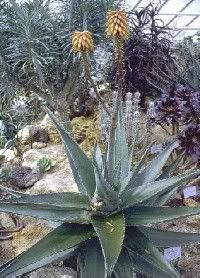

Folk Names: Barbados Aloe, Bombay Aloe, Burn Plant, Curacao Aloe, Medicine Plant, Moka Aloe, Saber (Arabic- Patience), Savila, Turkey Aloe, Zanzibar Aloe
Description: The aloe is native to East and South Africa, the West Indies, Florida, Texas, and Arizona. It is a perennial member of lily family with nearly 200 species. A succulent, it prefers dry sunny places and sandy soil. Though it grows readily in the wild, it has also become a popular house plant requiring little attention. Aloe has a long fibrous root giving rise to a rosette of fleshy basal leaves. The one to two foot long leaves are narrow-lanceolate and whitish-green on both sides with spines along the margins. From June to September, reddish, yellow, orange, purplish, or whitish green drooping flowers grow from a long raceme at the top of a singular flower stalk, simple or branching, which is four and one-half to twenty feet in length. The flowers produce triangular seedpods with many seeds. Some species are more tree-like with forked branches, while species such as A bainesii grows an average of sixty-five feet high and fifteen feet wide at the base.
Effects: gentle
Planet: Moon, Mars, Pluto
Element: Water
Associated Deities: Venus
Traditions:
According to John 19:39, Aloe was used to embalm the body of Christ. Muslims, especially of Egypt, consider the aloe a religious symbol. A Muslim who has made the pilgrimage to the shrine of Mohammed is entitled to place the aloe over his door. This is said to protect the household from any evil. Jewish people of Egypt also hang the aloe over their doors however. It has come to symbolizes the time spent between death and rebirth and is sometimes planted on graves to promote peace until resurrection.
Magic:
Grown as a houseplant, aloe is protective. It guards against evil influences and household accidents. In Africa, it is hung over houses and doors to drive away evil and bring good luck.
Aloes are said to ease loneliness as well. To attract a new lover, stand outside in the light of a full moon, taking a handful of crushed aloes in each hand. Beginning in the north, toss some of the aloes while saying: Come, love, come from the North. Repeat to East, South, and West. A new love will come into your life before the next new moon.
Known Combinations:
In Mexico, wreaths are made with Garlic bulbs strung on wires, festooned with icons, packets of magical herbs, lodestones, rock salt, Pine nuts, and clumps of fresh cut aloe. Hung in the home, such a charm is said to bring luck, success, money, and protection.
To arouse lust in one who has no interest in sex, mix powdered aloe with Love Oil and anoint the big toe of the right foot.
Medical Indications: Caution: Some individuals have a rare allergy to aloe. Before application, place a small amount on the underarm or behind your ear and if stinging or rash occurs, do not use. Aloe should not be used internally during pregnancy, or by people suffering from hemorrhoids. Parts Used : leaf pulp
Aloe is an astringent, emollient, antifungal, antibacterial, and antiviral, purgative, and vulnerary. As purgative, it has a tendency to cause gripe and constipate and should be combined with carminative for best results. Taken in small amounts, it can soothe stomach irritation. The leaves contain a thick, slimy gel which can be applied for skin problems such as sunburn and other minor burns, wrinkles, insect bites, skin irritations, minor cuts and scratches. Aloe stimulates cell regeneration and may also be considered helpful for radiation burns caused by cancer treatments. It may be used specifically for suppressed or obstructed menstruation, dyspepsia, skin lesions, liver disease, and headaches. Pliny suggested aloe extract as a tonic, purgative, and for jaundice. A decoction may be made for tapeworms, and this solution may also be applied to the nipples when attempting to wean a child.
Nutrition:
None noted
Mercantile Uses:
Aloe is used in many popular shampoos, conditioners, and skin products. For balding, apply a white vinegar and aloe mixture. Leave this on the scalp for a few minutes before shampooing. The aloe is a very well-liked houseplant. My mother has had one longer than Iím alive, and it probably weighs as much as I do too. Aloes require two to three years before their juice is ready for harvesting. In the West Indies, they are laid out in rows in plantations while in Africa, the wild aloes are harvested. Cuttings take place in March or April.